2012 YAMAHA FZ1-N service
[x] Cancel search: servicePage 40 of 106
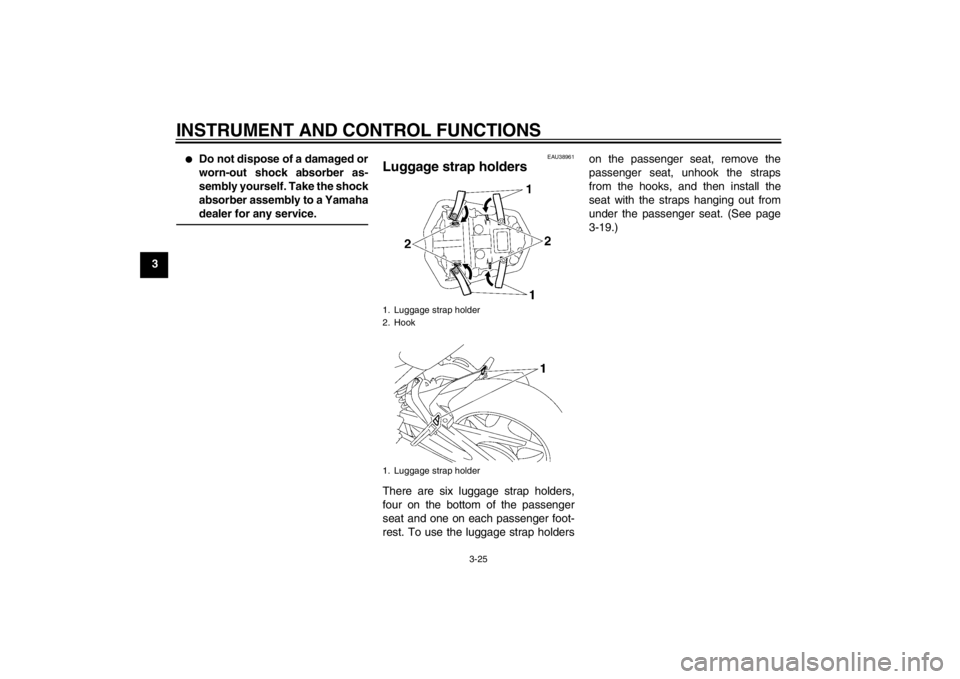
INSTRUMENT AND CONTROL FUNCTIONS
3-25
3
●
Do not dispose of a damaged or
worn-out shock absorber as-
sembly yourself. Take the shock
absorber assembly to a Yamaha
dealer for any service.
EAU38961
Luggage strap holders There are six luggage strap holders,
four on the bottom of the passenger
seat and one on each passenger foot-
rest. To use the luggage strap holderson the passenger seat, remove the
passenger seat, unhook the straps
from the hooks, and then install the
seat with the straps hanging out from
under the passenger seat. (See page
3-19.)1. Luggage strap holder
2. Hook
1. Luggage strap holder
U1ECE1E0.book Page 25 Monday, August 8, 2011 11:52 AM
Page 51 of 106
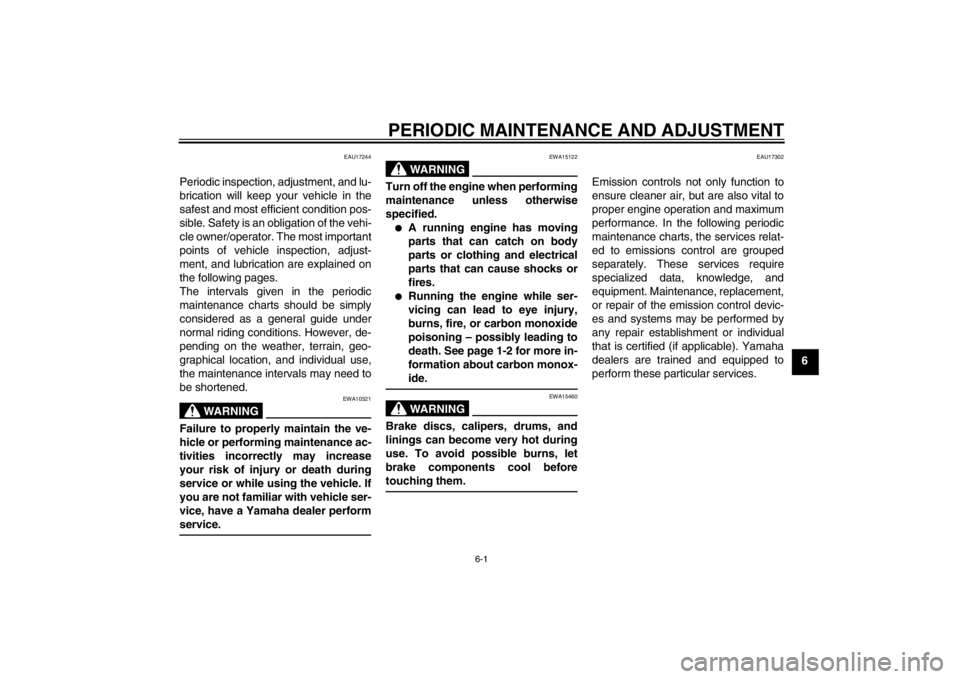
PERIODIC MAINTENANCE AND ADJUSTMENT
6-1
6
EAU17244
Periodic inspection, adjustment, and lu-
brication will keep your vehicle in the
safest and most efficient condition pos-
sible. Safety is an obligation of the vehi-
cle owner/operator. The most important
points of vehicle inspection, adjust-
ment, and lubrication are explained on
the following pages.
The intervals given in the periodic
maintenance charts should be simply
considered as a general guide under
normal riding conditions. However, de-
pending on the weather, terrain, geo-
graphical location, and individual use,
the maintenance intervals may need to
be shortened.
WARNING
EWA10321
Failure to properly maintain the ve-
hicle or performing maintenance ac-
tivities incorrectly may increase
your risk of injury or death during
service or while using the vehicle. If
you are not familiar with vehicle ser-
vice, have a Yamaha dealer perform
service.
WARNING
EWA15122
Turn off the engine when performing
maintenance unless otherwise
specified.●
A running engine has moving
parts that can catch on body
parts or clothing and electrical
parts that can cause shocks or
fires.
●
Running the engine while ser-
vicing can lead to eye injury,
burns, fire, or carbon monoxide
poisoning – possibly leading to
death. See page 1-2 for more in-
formation about carbon monox-
ide.WARNING
EWA15460
Brake discs, calipers, drums, and
linings can become very hot during
use. To avoid possible burns, let
brake components cool before
touching them.
EAU17302
Emission controls not only function to
ensure cleaner air, but are also vital to
proper engine operation and maximum
performance. In the following periodic
maintenance charts, the services relat-
ed to emissions control are grouped
separately. These services require
specialized data, knowledge, and
equipment. Maintenance, replacement,
or repair of the emission control devic-
es and systems may be performed by
any repair establishment or individual
that is certified (if applicable). Yamaha
dealers are trained and equipped to
perform these particular services.
U1ECE1E0.book Page 1 Monday, August 8, 2011 11:52 AM
Page 52 of 106
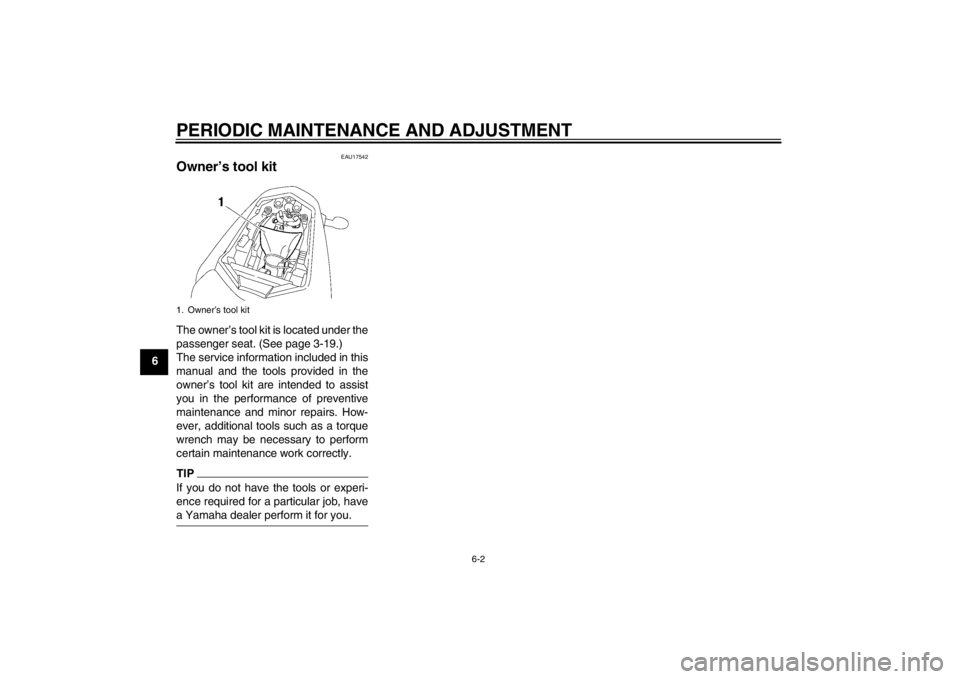
PERIODIC MAINTENANCE AND ADJUSTMENT
6-2
6
EAU17542
Owner’s tool kit The owner’s tool kit is located under the
passenger seat. (See page 3-19.)
The service information included in this
manual and the tools provided in the
owner’s tool kit are intended to assist
you in the performance of preventive
maintenance and minor repairs. How-
ever, additional tools such as a torque
wrench may be necessary to perform
certain maintenance work correctly.TIPIf you do not have the tools or experi-
ence required for a particular job, have
a Yamaha dealer perform it for you.1. Owner’s tool kitU1ECE1E0.book Page 2 Monday, August 8, 2011 11:52 AM
Page 57 of 106
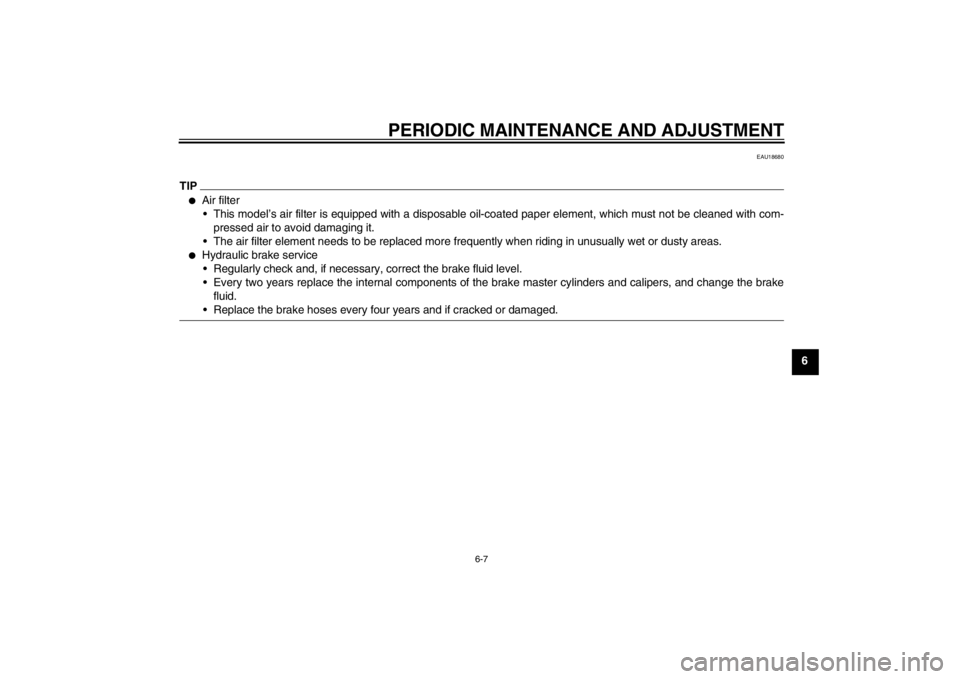
PERIODIC MAINTENANCE AND ADJUSTMENT
6-7
6
EAU18680
TIP●
Air filter This model’s air filter is equipped with a disposable oil-coated paper element, which must not be cleaned with com- pressed air to avoid damaging it.
The air filter element needs to be replaced more frequently when riding in unusually wet or dusty areas.
●
Hydraulic brake service Regularly check and, if necessary, correct the brake fluid level.
Every two years replace the internal components of the brake master cylinders and calipers, and change the brake fluid.
Replace the brake hoses every four years and if cracked or damaged.
U1ECE1E0.book Page 7 Monday, August 8, 2011 11:52 AM
Page 76 of 106
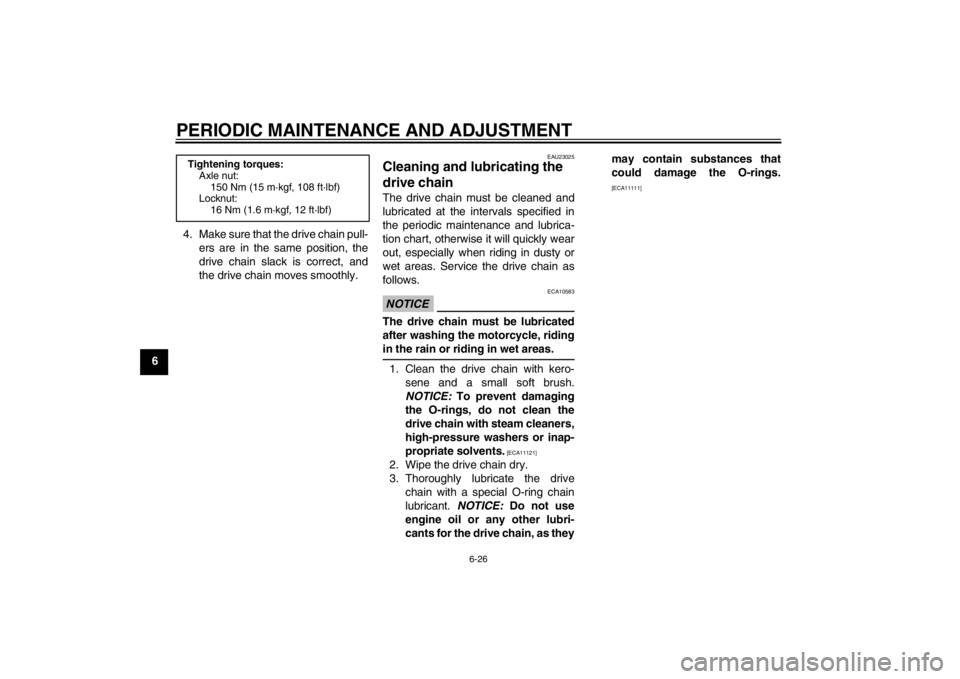
PERIODIC MAINTENANCE AND ADJUSTMENT
6-26
64. Make sure that the drive chain pull-
ers are in the same position, the
drive chain slack is correct, and
the drive chain moves smoothly.
EAU23025
Cleaning and lubricating the
drive chain The drive chain must be cleaned and
lubricated at the intervals specified in
the periodic maintenance and lubrica-
tion chart, otherwise it will quickly wear
out, especially when riding in dusty or
wet areas. Service the drive chain as
follows.NOTICE
ECA10583
The drive chain must be lubricated
after washing the motorcycle, riding
in the rain or riding in wet areas.1. Clean the drive chain with kero-sene and a small soft brush.
NOTICE: To prevent damaging
the O-rings, do not clean the
drive chain with steam cleaners,
high-pressure washers or inap-
propriate solvents.
[ECA11121]
2. Wipe the drive chain dry.
3. Thoroughly lubricate the drive chain with a special O-ring chain
lubricant. NOTICE: Do not use
engine oil or any other lubri-
cants for the drive chain, as they may contain substances that
could damage the O-rings.
[ECA11111]
Tightening torques:
Axle nut:
150 Nm (15 m·kgf, 108 ft·lbf)
Locknut:
16 Nm (1.6 m·kgf, 12 ft·lbf)
U1ECE1E0.book Page 26 Monday, August 8, 2011 11:52 AM
Page 88 of 106

PERIODIC MAINTENANCE AND ADJUSTMENT
6-38
6
EAU24350
Supporting the motorcycle Since this model is not equipped with a
centerstand, follow these precautions
when removing the front and rear
wheel or performing other maintenance
requiring the motorcycle to stand up-
right. Check that the motorcycle is in a
stable and level position before starting
any maintenance. A strong wooden
box can be placed under the engine for
added stability.
To service the front wheel1. Stabilize the rear of the motorcycle by using a motorcycle stand or, if
an additional motorcycle stand is
not available, by placing a jack un-
der the frame in front of the rear
wheel.
2. Raise the front wheel off the ground by using a motorcycle
stand.
To service the rear wheel
Raise the rear wheel off the ground by
using a motorcycle stand or, if a motor-
cycle stand is not available, by placing a jack either under each side of the
frame in front of the rear wheel or under
each side of the swingarm.
EAU44791
Front wheel (for non-ABS
models)
WARNING
EWA14840
For the ABS model, have a Yamaha
dealer remove and install the wheel.
EAU39394
To remove the front wheel
WARNING
EWA10821
To avoid injury, securely support the
vehicle so there is no danger of it
falling over.1. Loosen the front wheel axle pinch
bolt, then the wheel axle and the
brake caliper bolts.
U1ECE1E0.book Page 38 Monday, August 8, 2011 11:52 AM
Page 91 of 106

PERIODIC MAINTENANCE AND ADJUSTMENT
6-41
6
EAU39413
To install the rear wheel1. Install the wheel and the brake cal- iper bracket by inserting the wheel
axle from the left-hand side.TIP●
Make sure that the slot in the brake
caliper bracket is fit over the retain-
er on the swingarm.
●
Make sure that there is enough
space between the brake pads be-
fore installing the wheel.
2. Install the drive chain onto the rearsprocket.
3. Install the axle nut. 4. Lower the rear wheel so that it is
on the ground, and then put the
sidestand down.
5. Adjust the drive chain slack. (See page 6-25.)
6. Tighten the axle nut, and then tighten the locknuts to the speci-
fied torques.
EAU25871
Troubleshooting Although Yamaha motorcycles receive
a thorough inspection before shipment
from the factory, trouble may occur dur-
ing operation. Any problem in the fuel,
compression, or ignition systems, for
example, can cause poor starting and
loss of power.
The following troubleshooting charts
represent quick and easy procedures
for checking these vital systems your-
self. However, should your motorcycle
require any repair, take it to a Yamaha
dealer, whose skilled technicians have
the necessary tools, experience, and
know-how to service the motorcycle
properly.
Use only genuine Yamaha replace-
ment parts. Imitation parts may look like
Yamaha parts, but they are often inferi-
or, have a shorter service life and can
lead to expensive repair bills.
WARNING
EWA15141
When checking the fuel system, do
not smoke, and make sure there are
no open flames or sparks in the ar-
ea, including pilot lights from water
1. Slot
2. Retainer
Tightening torques:Axle nut:150 Nm (15 m·kgf, 108 ft·lbf)
Locknut:
16 Nm (1.6 m·kgf, 12 ft·lbf)
U1ECE1E0.book Page 41 Monday, August 8, 2011 11:52 AM
Page 99 of 106

SPECIFICATIONS
8-1
8
Dimensions:Overall length:2140 mm (84.3 in)
Overall width:
770 mm (30.3 in)
Overall height: 1060 mm (41.7 in)
Seat height: 815 mm (32.1 in)
Wheelbase:
1460 mm (57.5 in)
Ground clearance: 135 mm (5.31 in)
Minimum turning radius: 3000 mm (118.1 in)Weight:Curb weight:FZ1-N 214 kg (472 lb)
FZ1-NA 221 kg (487 lb)Engine:Engine type:Liquid cooled 4-stroke, DOHC
Cylinder arrangement:
Inline 4-cylinder
Displacement: 998 cm³
Bore × stroke:
77.0 × 53.6 mm (3.03 × 2.11 in)
Compression ratio:
11.50 : 1
Starting system: Electric starter
Lubrication system: Wet sump
Engine oil:Recommended brand:YAMALUBE
Type:
SAE 10W-30, 10W-40, 10W-50, 15W-40,
20W-40 or 20W-50
Recommended engine oil grade: API service SG type or higher, JASO
standard MA
Engine oil quantity:
Without oil filter cartridge replacement:2.90 L (3.07 US qt, 2.55 Imp.qt)
With oil filter cartridge replacement:
3.10 L (3.28 US qt, 2.73 Imp.qt)Cooling system:Coolant reservoir capacity (up to the
maximum level mark):0.25 L (0.26 US qt, 0.22 Imp.qt)
Radiator capacity (including all routes): 2.25 L (2.38 US qt, 1.98 Imp.qt)Air filter:Air filter element:Oil-coated paper element
Fuel:Recommended fuel:Regular unleaded gasoline only
Fuel tank capacity:
18.0 L (4.76 US gal, 3.96 Imp.gal)
Fuel reserve amount: 3.4 L (0.90 US gal, 0.75 Imp.gal)Fuel injection:Throttle body:
ID mark:2D11 20Spark plug(s):Manufacturer/model: NGK/CR9E
Spark plug gap: 0.7–0.8 mm (0.028–0.031 in)Clutch:Clutch type:Wet, multiple-discTransmission:Primary reduction ratio:
1.512 (65/43)
Final drive: Chain
Secondary reduction ratio: 2.647 (45/17)
Transmission type:
Constant mesh 6-speed
Operation: Left foot operation
Gear ratio: 1st:2.533 (38/15)
–20 –10 0 1020 30 40 50 �C
10 30 50 70 90 110
0 130 �F
SAE 10W-30
SAE 15W-40SAE 20W-40SAE 20W-50
SAE 10W-40SAE 10W-50
U1ECE1E0.book Page 1 Monday, August 8, 2011 11:52 AM